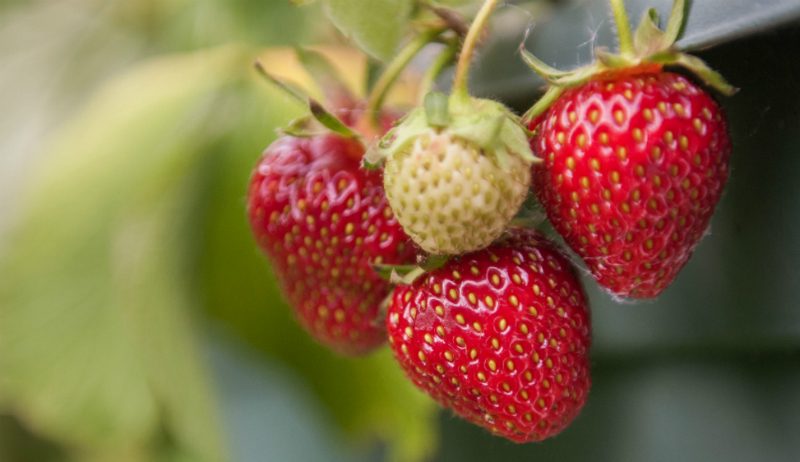
Vegetable gardening with kids can be a lot of fun. Here’s a list of fruits and vegetables perfectly suited to a children’s garden to help get you started. But don’t let the fun stop here—let your kids’ imaginations run wild and don’t be afraid to try something new in the gardening realm.
1. Parisian Carrots

Carrots tend to be a favorite when vegetable gardening with children, but we love this small, round, heirloom for small hands to harvest. Parisian carrots have a consistently sweet flavor, and are ready to harvest in a shorter amount of time than full-length carrots. They grow well in difficult clay or rocky soil but are also perfectly sized for container gardening. Be sure to provide this variety plenty of water, and they’ll be sure not to disappoint your little ones.
2. Easter Egg Blend Radishes

What could be more fun than an Easter egg hunt? Digging up colorful radishes in pink, purple, red and white, of course. While radishes might not be at the top of your little eaters’ favorite-foods list, kids will want to pop one of these pretty, mild-flavored globes into their mouths after having pulled them from the ground. Easter egg radishes have a crisp, mild flavor and can be harvested in just a few weeks after direct-sowing into the garden.
If your kids are hesitant to eat the radishes raw, consider baking them with a little salt and butter to bring out their sweetness. Or mix them raw in a food processor with a stick of butter to spread on bread as a snack—the butter mellows out the radishes’ bite.
3. Strawberries

Strawberries are a no-brainer for children’s vegetable gardening because kids love them, they come back year after year, and they will spread on their own to fill the container you plant them in. When choosing strawberry plants, look for everbearing varieties, which produce fruit all season long. For something a little different, try pineberry strawberries, a white variety that tastes like pineapple.
4. Cherry Tomatoes

Tomatoes are a must for adults and children in vegetable gardening because the flavor of a garden-grown tomato beats a store-bought variety every time. Cherry tomatoes in particular capture the imaginations of children, perhaps because they are so plentiful and easy to pick. A child just can’t help but pop a few in his or her mouth while wandering through the garden. Try sweet, disease-resistant varieties such as Sun Sugar (a yellow cherry tomato) or Super Sweet 100 ( a red tomato)—but be aware that they might do better in raised beds than in pots and will need to be staked or caged to keep their indeterminate vines off the ground.
5. Purple Potatoes

Growing potatoes is like growing your own buried treasure. While any type of potato can be fun for youngsters in a vegetable gardening project, kids will be especially delighted by purple varieties—and it can be an excuse for you to introduce more color into their diets.
To plant, cut seed potatoes so there’s at least one eye per piece. Space the potato pieces at least 3 feet apart in the garden and about 5 inches deep. As the plants begin to sprout, hill up the soil around the stalks until the plants begin to blossom. (For containers, choose a deep container, and add soil to it as the plant begins to grow.) Then continue watering them. Once the plants begin to die back, you can dig up the potatoes. Feel free to dig them up all at once, or leave potatoes in the ground to preserve them until you’re ready to use them.
6. Sugar Snap Peas

A cross between flat snow peas and garden peas whose pods are inedible, sugar snap peas are a fun addition to a children’s garden because they can be eaten fresh or cooked, whole pod or not. Look for stringless varieties so that small children don’t choke on the strings. The peas can be planted straight into the garden in early spring and will need to be trellised. Incorporate something fun into the garden as a trellis, such as the side of the children’s swing set or a teepee trellis that the kids can climb inside.
7. Baby Greens Mix

This is another small plant for small hands and one that will work well in containers as well as raised beds. By incorporating a mix of greens—spinach, kale, chard, arugula and others—your children will get to explore a variety of colors, textures and flavors while getting their daily dose of roughage. Start planting baby greens when the weather is still cool, and continue to sow until warm weather causes plants to bolt and turn bitter. Have children harvest with scissors daily or as leaves are big enough for a tender salad mix. If they don’t get to the harvest in time, don’t sweat it—the full-grown versions of the greens are just as tasty.
8. Okra

Okra is a fun plant for kids because it’s a flower as well as a vegetable. During the day, okra plants boast big beautiful flowers (which can be eaten, too, if you want to try a fun experiment). The okra grows very quickly once it comes onto the plant. Your children will be amazed at how its size changes from day to day, and there will always be something for them to harvest. To add an extra splash of color to the garden, look for a red variety, or plant a mix of green and red okra.
This article about vegetable gardening with children was written for Hobby Farms magazine online and is regularly updated. Click here to subscribe.




